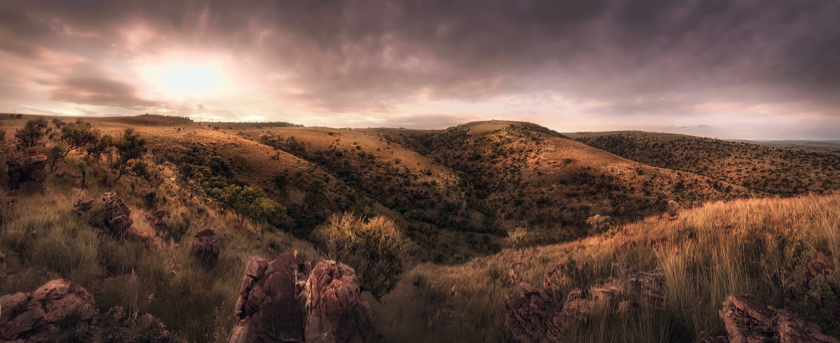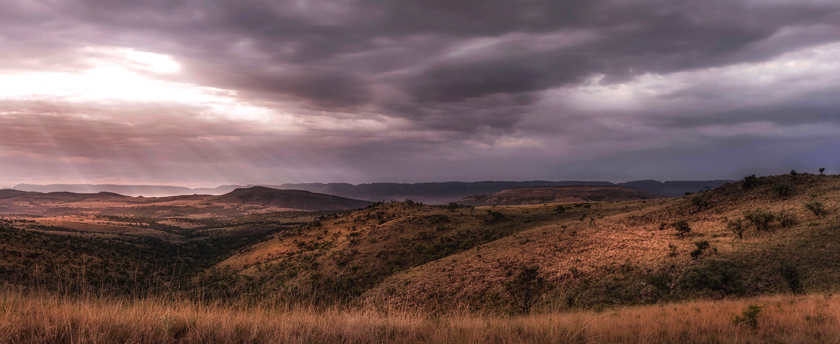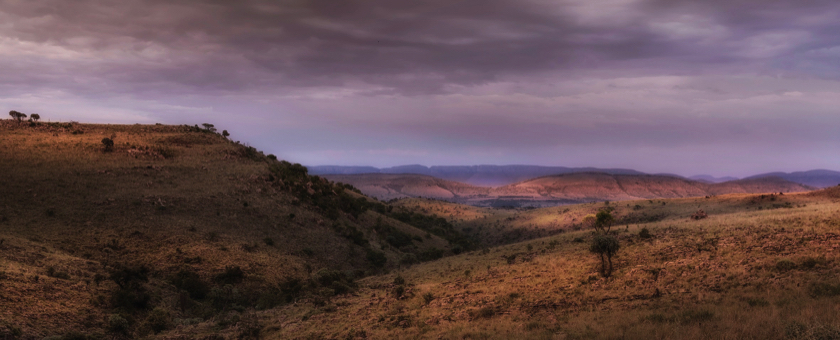EMERGING EARTH LAB
VISION
The Cradle of Humankind, a UNESCO World Heritage Site, lies 60 km north of Johannesburg in the heart of Southern Africa. It is one of three areas on earth where our hominin ancestors evolved. For approximately 2.5 million years it served as an evolutionary laboratory for Homo sapiens. With humanity facing a multifaceted existential crisis, our proposal is to construct another laboratory here, an interdisciplinary African institute where research is symbiotically linked to practical implementation. A laboratory that decisively dissects, confronts and takes action on the threats to the collective future of most species inhabiting planet Earth.
IMPERATIVE
The future of Planet Earth's inhabitants is precariously balanced on the edge of an existential precipice. The causes and most consequences of the climate crises have been meticulously documented. They compound multiple existing developmental challenges. At the same time our networked world is more vulnerable than ever before. The devastation caused by the Corona virus pandemic is a continuing grim and urgent reminder of the precariousness of our collective futures. The need to explore and develop comprehensive and robust solutions has never been more pressing. The time to intervene proactively on every level is now.
While not a major contributor to global warming, Africa is disproportionately having to shoulder the collective burden of its costs. Rapid urbanization driven by conflict and climate change poses enormous developmental challenges. But Africa should not and cannot follow the high-pollution growth models pursued by Britain, Europe, the US, Japan, China and India while at the same time paying for costs accrued by others.
This raises fundamental questions. How does Africa promote resilience and well-being with limited resources, given that by the mid twenty first century one in every three children born on our planet will be African?
How does Africa present a more powerful voice to claim the resources needed to adapt to a more self-sufficient future? How does Africa educate and empower its leaders to implement sustainable change? And how does Africa effectively contribute to the global challenges of issues of climate change?
The response to these questions has most often been political expediency and inaction on the part of governments and multinational corporations, or prescriptive one-size-fits-all policies with their origins outside Africa. Long-sighted and Africa-oriented solutions are rare and often disciplinarily fragmented. Yet it is only a coordinated and multi-facetted response that can confront the complexity of key existential and developmental challenges. Not least, the profound impact of Covid and the ever-present threat of other emerging infectious diseases, has exposed issues and opportunities that must be responded to in scientifically rigorous and implementable ways.
AN AFRICAN INITIATIVE
EX AFRICA SEMPER ALIQUID NOVI
With the full support of and in collaboration with the University of the Witwatersrand and the University of Stellenbosch, we propose the establishment of EEL, the Emerging Earth Laboratory, tasked with unearthing and developing practical, politically deliverable and sustainable solutions to this intensifying crisis in Africa.
EEL recognises that complex problems remain unsolved partly because of institutional devotion to compartmentalised disciplines and partly because of a distinction between academic thought and real-world action. Consequently, the lab's core principle is that a synthesis of disciplines and perspectives are necessary to find solutions – a interdisciplinary nucleus of renowned African and international experts and an open door to the business and political leaders of the present and the future. EEL will have no departments. Instead, an advisory board will identify and co-ordinate the priority areas for research and choose those best qualified to do this work. EEL will function not only as a seedbed for future strategies but will also facilitate the flow of ideas through to real world implementation. Results analysis will ensure that positive action will be pursued and implemented. It will be outward looking as it provides an African perspective to the global discourse on issues like climate change, population growth, food security,emerging diseases and the accelerating extinction of species.
Crucially, EEL's outreach from the very beginning will be both onsite and online. It can profile its programmes very effectively this way and draw a wide global audience from the start.
The intention, fleshed out in the attachment to this proposal, is to draw people from across the African continent and the world together, either as Fellows in Residence or as visitors and participants online, to undertake cutting edge thought, conversation and - crucially - the core purpose of EEL: to turn that research into action.
The Emerging Earth Lab, imbued with its unique history, will give the most creative thinkers the space and inspiration to do this. Where else to better focus these minds…
THE CRADLE OF HUMANKIND
In 1999 UNESCO designated the area known as the Cradle of Humankind as a World Heritage Site. Scientific evidence confirms that the area has been occupied by various hominin species for approximately 2.9 million years and by Homo Sapiens for the last 90 000 years.
The International Council on Monuments and Sites (ICOMOS) have confirmed that much of the physical landscape in this area has remained unchanged over the last one million years, from the mid Pleistocene up to modern times. These images reflect an almost unchanged landscape, the same landscape that was home to some of the very first members of our species.
ARCHITECTURE
Organically immersed in this landscape, the EEL will be an inspirationally symbolic space designed as a globally unifying aesthetic statement by internationally acclaimed architect Laertis Vassiliou.
Designed and constructed as a timeline of planet earth – three separate spaces connect through a spine, representing the Past, Present and Future of our planet and our relationship to it.
Carbon neutral, self-sustainable and constructed with natural and indigenous materials, with similar textures and colours, EEL will be sculpted and respectfully contextualised within the landscape. From concept to construction, modularity has and will be key and central to all fundamental design decisions so as to facilitate future opportunities for infrastructural growth and development.
MANAGEMENT
All management aspects of EEL will be accountable to an independent trust, chosen by the initial stakeholders. Initially an executive board, itself answerable to the trust, will oversee procurement, construction and completion of the buildings.There will be periodic and independently conducted reviews to ensure quality and impact.
The Academic component of EEL will be smart and lean. EEL will be spearheaded by a Director, rotating every four years, a senior administrator, an events organiser and a financial manager. The key editorial decisions will be taken by an Advisory Board, drawn from partners and representatives from South African and African universities and think tanks, and from like-minded academics, public intellectuals and practitioners from elsewhere in the world. These will include the central collaborative combination of Prof Sarah Nuttall and Prof Achille Mbembe from the University of the Witwatersrand's WISER unit, and Prof Mark Swilling, Distinguished Professor of Sustainable Development at the University of Stellenbosch.
The Board will be at the heart of this project and actively drive its programmes A mixture of offline and online Board meetings will steer EEL and propel it forwards.The Advisory Board will identify the key issues and projects that will be taken on by Fellows in Residence and members of other institutions attached to particular projects.
These projects will be budgeted, audited and completed within strict time-frames.The Director, in discussion with the Advisory Board will manage the site, oversee the appointment of Fellows and define and institute the programme for the upcoming year.
FUNDING
Funding will be raised in four stages:
1. To cover the initial costs of design and planning.
2. Construction of EEL.
3. Concurrent with construction we will build a virtual EEL on-line. This will commion in projects, act as a pilot for the program and generate publicity for EEL.
4. To cover core administrative costs and key programmes.
Most individual programmes will be grant-funded.
CONCLUSION
The current multi-faceted global crisis presents an urgent need to redefine economic systems and political ideologies. It requires deeply researched and implemented solutions and a globally unifying response to this unprecedented threat facing humanity.
Building the Emerging Earth Laboratory in this inspiring valley imbued with humankind's origins is a uniquely symbolic and compelling path to accomplish this.
This is an African declaration of intent and an urgent call to Homō Sapiēns to collectively live up to our name.
Wise Sensible Judicious Human Being


